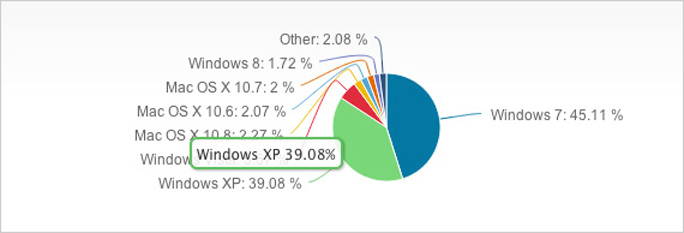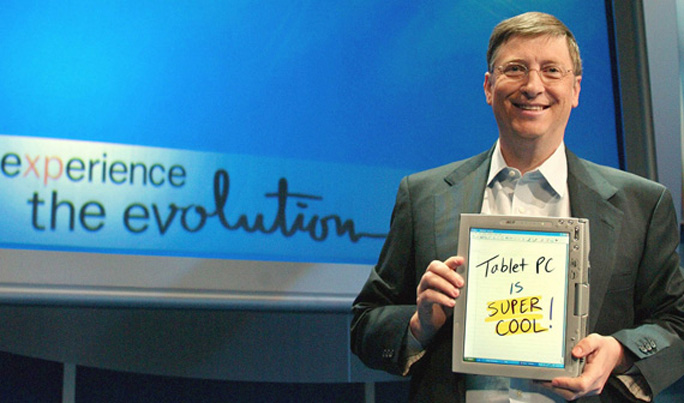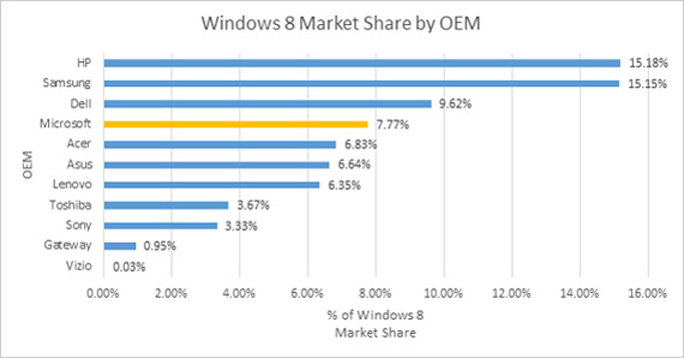4 UX principles Microsoft forgot about in Windows 8
- Transfer

Translation of "The 4 UX Principles Microsoft Forgot That Doomed Windows 8" from Usabilla.com.
When choosing the future for Windows, Microsoft made a risky bet on creating an operating system that would work equally well for tablets and desktop computers. This seemingly very reasonable strategy was doomed to failure for several reasons; by and large, the thing is that Microsoft has forgotten about the necessary basics.
They do not know their client. They do not solve any problem. They did not study users, and it is not clear what they still wanted to say with their new product.
My story today about how Microsoft famously miscalculated is just another attempt to show what happens to those who violate the basic principles of UX and business.
Microsoft features
Microsoft continues to be a leading player in the operating system market. Of course, if you look around right now, this statement may seem debatable to you (after all, it is quite possible that you are currently sitting at work, where Apple laptops are surrounded on all sides). However, according to research conducted by NetMarketShare , in December 2012, Microsoft controlled 91.74% of the market for operating systems for desktop computers and laptops.


One in three users is still working on an operating system released in 2001 ( Source )
Meanwhile, Windows 7 finally got the status of the most widely used OS - even if this event happened only in August 2012; but pay attention to something else - even in December, Windows XP continued to account for 39% of the total number of Windows computers. This figure means that more than one out of three computers today continues to use the OS, which was released back in 2001 - and this happened, imagine, already 12 years ago. Not every one of us can boast that he walks with a mobile phone, which is already over 12 years old, or uses any technology with the same statute of limitations.
Among other technological products, Windows XP looks like a real zombie. She was supposed to go to the grave a few years ago, but, apparently, nothing could stop her. Yes, and Windows 7 was able to drag the blanket over itself and attract such a percentage of users only because Microsoft refused to continue selling Windows XP.
Now that only a year and a half remainsbefore the end of any support for Windows XP, selling to Windows 8 users should be simple - after all, do not forget that every third desktop user needs to be updated a long time ago. And if we close our eyes to the tragedy that happened with Windows Vista, then we can assume that the approximate percentage of users switching to the new version of Windows is almost 50%. From all this we come to a seemingly obvious conclusion - the task of "forcing" users to upgrade to Windows 8 can be considered already solved.
So why aren't users updated?
In the same diagram, it is noticeable that the percentage of users who switched to Windows 8 is 1.72%. This is a worthy result for the software that was released on October 26 last year (we will not take into account the fact that individual versions were available from August 1). Microsoft has officially confirmed that sales for the first weekend after the launch were more than 4 million copies, but recent rumors unanimously confirm that subsequent sales figures were disappointing.
Paul Tarot, author with Supersite For Windows, a source from Microsoft itself quoted in November: “Sales of PCs on Windows 8 turned out to be much lower than the bar that Microsoft had hoped for, and they are not called disappointing in the company except for anything.” According to the same Tarot, they decided to blame what was happening on “the inexpressive design of the manufactured PCs and their inaccessibility”.
With all due respect to Paul’s opinion and his research, I would like to suggest a slightly different reason why Microsoft is having difficulty selling Windows 8.
Mantra UX
You can read about the mantra here , this is a squeeze from “ A Better User Experience ”. In short, its essence is “product, market, message, user achievement”.
Simply put, if you want to sell something, first you need to understand who you are going to sell it to, how you plan to reach out to these people and which approach will work best for selling your product. If you know all the parts of the mantra, then you are on a path that can lead you to success.
In my opinion, both Surface and Windows 8 were notable for noticeable problems on all of the above points. However, Microsoft should be given its due - after so many years of skimming off the ideas spied on by Apple, they decided to withdraw from their homes and try something new.
If we go beyond discussing exclusively desktop computers, then the main successes achieved by Microsoft in recent years will immediately become noticeable. Of course, the Xbox division will be the best example. In addition to the fact that the notorious “red ring of death” problem has finally sunk into oblivion, the game console has received support in the form of Kinect and Xbox Live service remade from scratch. The latest update to Xbox Live completely allowed Microsoft to go beyond the gaming market, opening it the way to the endless realm of home entertainment.
The mobile phone division is also enjoying some success. They did a good job of creating their own niche for Windows Phone - this is understandable already by how much attention the NY Times authors pay to them .
It turns out that in areas that are not related to desktop computers, Microsoft is decisively moving forward.
Many have heard about the fact that despite the fact that all the glory went to the iPad, the first tablet computer was still shown by Bill Gates. This tablet worked, by the way, running a full-fledged Windows XP.

It is not known how Ballmer came up with the idea to create a chimera, which will later be called Windows 8, but it seems to me that this happened at the time of another bout of thought in the spirit of “What would Bill do.” Steve saw a photograph, remembered a long-forgotten idea, and suddenly realized the fact that the OS can be used on the tablet in exactly the same form as on a “large” computer - all that was left was to pull over all this UI from Windows Phone. All is ready;You can celebrate the victory .
No one denies that the resulting result is worthy of the title of the original creation: a half-desktop, half-tablet OS, which can easily confuse those who try to use it, and which cannot properly support most of the hardware of desktop computers released at the moment.
Problem One: The Market Does Not Exist
The first problem is immediately evident, and Paul Tarot points to it: for Windows 8, a pre-prepared market was not created.
In order to get maximum convenience from Windows 8, the user must have a computer that combines the functionality of both a simple PC and a tablet. At the time of writing these lines, there are not many options. Computer manufacturers are rapidly filling a gap in the market, but the only finished and regularly advertised device for Windows 8 has been and remains manufactured by Microsoft itself - and this is Surface.
Microsoft itself is in 4th place for the supply of OEM devices with Windows 8.

The fact remains: the problem # 1, which stands in the way of distributing Windows 8, is the insufficient number of PCs ready for use at home and in the workplace that could allow the use of all the innovations of Windows 8. My assumption is that as long as the companies out of a hundred Fortune and the government will not switch to such desktop / tablet type hybrid devices, Windows 8 will continue to experience low sales. And in the last note there is no error - Windows 8 has already suffered from a low percentage of transition to it. Believe it or not, Windows 8 at the current stage of its life cycle has a lower percentage of transitions to it than in the famous case of Vista.

This is not the only thing Microsoft has suffered - it was also affected badly by the fact that their confusing message to consumers did not offer any impressive reasons for the update.
The second problem: they do not solve the problem
The main innovation of Windows 8 is its use as a single OS for tablets and desktop PCs. Take a closer look - this idea does not contain the idea of solving any problems in the lives of users.
The slow adoption of the OS was underscored by the fact that Windows 8 will require not only new computers, but also new skills. For business and education, this is not the best solution, because budgets in such cases are very limited, and the emphasis is not on fast-learning teenagers or children.
Problem Three 3: The message they want to transmit cannot offer anything and has no contact with the user
Most likely, you saw ads of Windows 8 or Surface. I’m not sure that an ordinary person can easily distinguish one clip from another. See for yourself.
This ad has been spinning around for months now. In it, students are active, continually connecting and disconnecting colored covers from their Surface. Well, if they do not mess around with covers, then slide their fingers on the screen. Let's try to figure out what the authors wanted to tell us. Most likely, they tried to show how important it is to actively use the tablet. Most likely, the inexperienced public in response will decide that they simply do not need it.
Take a look at another example.
By the way, I really like this advertisement. It represents one of the features of Windows 8 that I really like: a password in the form of a picture. In the video, people unlock their computers by simply moving their finger across the image. But you know what else I would like to see? How to send email? How is this feature related to other applications? I saw a child drawing on it, but I did not see a graphic designer who works in Photoshop.
Bright colors and active movements in the first advertisement; family idyll in the second; what do we have at the output? It feels like this Windows is not for business. It is made for fun.
If your main consumers are companies and the government, then this approach leads to an obvious problem. I am not the first to notice this error. Michael Birkin, Acer’s marketing director (one of Microsoft’s largest OEMs) recently suggested that “all product promotion is focused on a removable keyboard. As a result, users have no idea how to get the most out of it with touch. ” He also mentioned what advertising considers “confusing.”
I hardly have anything to add to his words.
The fourth problem: ignoring the experience of interaction
In pursuit of creating its hybrid, Microsoft has seriously ignored usability.
Deeply hidden functions, creating difficulties for interface learners, overloading cognitive perception due to the duality of the environment, reduced usefulness of the single-window mode and low information density on the screen. Too, too bad.
- Jacob Nielsen
Jacob Nielsen wrote an entire article entitled “ Windows 8 - Disappointment in Convenience for Both Beginners and Experienced, ” the conclusion of which you just read.
The following video reveals the duality of the new operating system.
Scientific American published an article, “ Why Touchscreens Can’t Get the Top ”, which contains an interesting theory that touchscreens will always remain niche devices because of the effect called the “gorilla hand”. Its essence lies in the fact that it is easier for any of us to move a hand lying on a table on a mouse than to wave our arms back and forth all day. Microsoft is trying to convince us otherwise. They bet that the world is ready for hybrid devices, and their “cash cow” acts as a bet. I prefer to keep healthy skepticism.
Some results
Microsoft has shown ineptitude in all aspects of launching and marketing Windows 8. Let's go over the main mistakes of the creators of this OS once again to never allow them in your own projects - or in case you suddenly have to go a similar road:
- Know your market: Microsoft has created a product that their current users do not need.
- Know the problem: Microsoft does not understand why people do not want to part with XP and love it so much. If they knew, they would take the part so beloved by everyone and throw everything else away.
- Know what you want to say: Microsoft has created such a messy message that even OEMs are already complaining about them. And all because Microsoft does not help Acer to promote its product. If you can’t imagine what your users want, then do not tell them that you have it. If you need to convince them of this - get ready to get out with all your might and hope that no one will notice it.
- Do not ignore the study of user behavior : A good UX includes convenience, comprehension, and responsiveness - you should not throw any of this away just because you think that “users don’t know what they want.” Users know what they want, even if it is not expressed in tangible form, but they will feel when something confuses or tires them. When research says one thing and you do another, get ready to take responsibility for it.
These are Ben's thoughts on Windows 8. What do you think of this?
